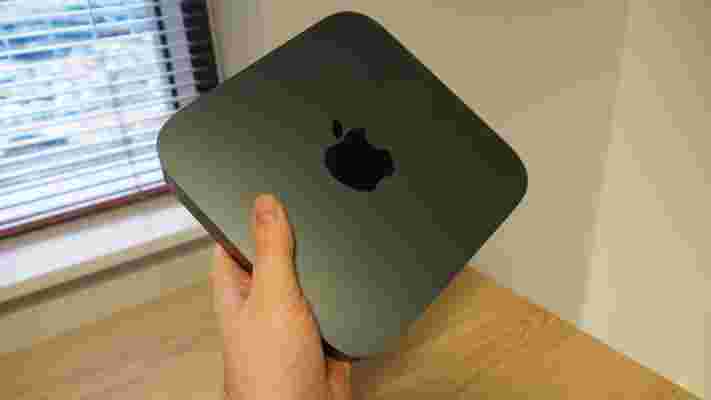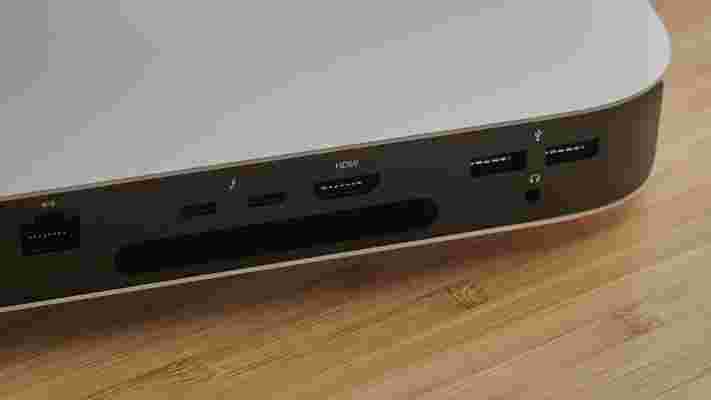A revamped Apple Mac Mini for 2022 is hotly anticipated, so like you, TechRadar's editors were surprised it didn't appear at Apple's Peek Performance event on March 8.
We did see something else for fans of the Apple desktop line: the Mac Studio, featuring the new M1 Ultra SoC (system-on-a-chip), designed with creative professionals in mind. But something is clearly brewing: Convincing new rumors say Apple is testing nine new Mac models ahead of WWDC with brand-spanking new M2 silicon chips -- and that includes a new Mac Mini.
It's been almost two years since Apple released the Mac Mini (M1) , powered by the Apple M1 chip alongside the Apple MacBook Air (2020) and 13-inch Apple MacBook Pro (2020) . So a new model – possibly powered by the same M2 chip that could also appear in the rumored MacBook Air (2022) – is definitely due.
The mini-PC impressed us when we reviewed it in 2020, and the M1 chip powering it showed itself to be a pretty competent performer overall. Still, a home PC is a pretty big piece of kit. Can a revamped 2022 Mac Mini win over converts beyond the device's fanbase? Here's everything we know so far.
Apple Mac Mini (2022): cut to the chase
April 15: Apple is testing a whole bunch of new Macs that are powered by its next-gen M2 chip -- including a new Mac Mini.
April 14: A firmware update for Apple’s new Studio Display references a product marked as Macmini10,1, which apparently is a model ID not used for any of the existing Mac product lines.
March 13: Bo-ring! Well-respected and (usually very well-informed) Apple analyst Ming-Chi Kuo says the upcoming Mac Mini will keep the existing form factor - and will show up in 2023. :-(
March 09: At its Spring "Peek Performance" event , Apple unveiled a new M1 Ultra chipset, the iPad Air 2022 , the iPhone SE 2022 , the fancy Mac Studio , and more! But no Mac Mini, unfortunately.
Release date and price

The Apple Mac Mini (2022) hasn't even been announced yet, so there's no official release date that we can confirm. The last Mac Mini (M1) was released in late 2020, so going off Apple's typical 18 to 24 product release cadence, we expected it to be announced at the March 2022 event, but sadly this wasn't the case. It's still likely we could see it announced before the end of the year though if Apple does have plans to release an M2 SoC.
The 2020 models of both products were announced at the same time, and both feature the M1 chip. There are also a lot of rumors that the 13-inch MacBook Pro won't see a major redesign, which might be reserved for a new MacBook Air reveal later this year.
If that is true, then it may make sense for the Mac Mini with M2 to be announced alongside the 13-inch MacBook Pro since there's much less excitement around a Mac Mini redesign than there is for a MacBook.
After all, announcing two new M2-powered devices that don't feature major redesigns is better than announcing just the one, and if the Mini were to only get internal improvements, swapping out the M1 for the M2 would make mass production significantly simpler.
More recent rumors from well-placed sources suggest that Apple might have decided to push back the Mac Mini 2022 to 2023 – and if that turns out to be the case, we're going to have to stop referring to it as the Mac Mini 2022.
Design

One of the major advantages to the Mac Mini is its size, which is perfect for those who need a home PC but don't want a large PC case or an all-in-one computer like the latest iMac . But will that change?
There has been a lot of talk about the potential redesign of Apple's MacBook Air (2022) as well as the lack of redesign for the 13-inch MacBook Pro. Which side of things do we expect the Mac Mini to come down on?
It's a hard question to answer, unfortunately: since there is less interest in seeing a Mac Mini redesign, there's less incentive for Apple to redesign the Mac Mini. However, one of the reasons why the lack of a redesign for the 13-inch MacBook Pro makes a lot of sense is that the 13-inch MacBook Pro might be discontinued after this year in favor of the 14-inch MacBook Pro (2021) .
If you're going to continue to release a product, and we don't expect the Mac Mini to be discontinued any time soon, then it's almost certain that it will have to get a redesign (albeit, nothing major) to fit in with other Mac products that do, namely the iMac, and presumably the MacBook Air and MacBook Pro 14-inch and MacBook Pro 16-inch .
The rumor mill has gone both ways on this, but earlier leaks hinting that a change in form factor was on the cards have since been shot down by other sources. We'll have to wait and see what the Mac Mini 2022 looks like.
Specs and performance
There's not much we can say specifically about the Mac Mini's specs without knowing the Apple chip that runs it, but we do expect that it will have the same 8GB/16GB Unified Memory configuration options, with anywhere from a 256GB SSD up to a 2TB SSD.
We also expect the number and types of ports to stay more or less the same, but we're hoping for an upgrade to USB-C Thunderbolt 4 from the existing Thunderbolt 3. Same goes for upgrades in the way of HDMI 2.1 and a DisplayPort 1.4 output, but with Thunderbolt 4, those ports might not be necessary anyway, so they might get the axe with a new Mac Mini.
That might shift around our list of best monitors for the Mac Mini , but something tells us this isn't much of a concern for Apple.
As for the chips powering the new device, that's where things can get interesting.
There is some buzz that we won't just see an M2-powered Mac Mini, but we might also see an M1 Pro and even an outside chance of an M1 Max-powered Mac Mini.
These latter two might be more for professionals rather than home PCs, but the possibility could give the Mac Mini much broader appeal, especially since it might allow consumers of all stripes to access the performance of an M1 Pro and M1 Max at a more accessible price point than you'd get with a MacBook Pro.
iPhone 14 could be getting my number one request
There might be a bigger optical zoom in Apple's upcoming iPhone 14 and I couldn't be more excited.
There's reason to believe Apple is gearing up to put an ultra-zoom-capable (above the current 3X) camera in the next iPhone. According to TheElec camera module maker Jahwa Electronics, which builds modules that combine optical image stabilization (OIS) and autofocus, gave Apple a grand tour of the South Korean company's facilities in Gumi, and Jahwa is now spending 191 billion won on building a brand new production line to support a new device.
Granted, these two elements - the Apple tour and a new facility - don't necessarily add up to Apple iPhone 14 Pro ultra or superzoom, but I'm willing to read the tea leaves. And it's not just me.
9to5Mac notes that Jahwa supplies camera modules to Samsung and that Jahwa's technologies are often used in support of a periscope camera system.
You need a periscope

Why is the periscope so important?
With the iPhone 13 Pro , Apple bumped up against the physical limits of linear lens technology, offering just 3X optical zoom while competitors like Samsung manage 10X.
The only way to deliver that zoom level is to increase the distance from the lens on the outside of the smartphone to the sensor. Samsung solved this puzzle by building a pericope design inside the phone that sends the image from the lens through a prism where it makes a 90-degree turn to travel a greater distance down to a sensor pointed at the top edge of the phone.
Apple can't get past the 3X (or maybe 5X) optical zoom threshold without introducing similar technology. While It won't build it on its own, it does make sense for Apple to work with a third-party supplier. It's also Apple's practice to demand bespoke designs and manufacturing from its partners, which brings us back to that new Jahwa production facility.
It might not make it
Can Jahwa build that plant to supply camera modules that might include periscope technology in time for the anticipated iPhone 14 launch in September or October 2022? Maybe not and most industry analysts, including noted industry oracle Ming-Chi Kuo), believe we won't see a periscope-sporting iPhone until 2023 .
Still, an iPhone fan can dream, and, if I'm being honest, I don't know if Apple can afford to wait another year while competitors like Samsung pull away on the optical zoom front.
Greater zoom doesn't just affect optical options. As we've seen with Samsung, once you have a longer optical zoom lens, you can combine that with crafty AI and image algorithms to build things like Space Zoom.
When I tested the Samsung Galaxy S22 Ultra earlier this year, I was stunned at what I could capture with 30X and 100X Space Zoom . I don't think any of that would've been possible without the 10X optical zoom as a foundation. (You can see an example image above.)
Apple has long had industry-leading image processing. Imagine what it could do with a periscope-supported 10X optical zoom. By the way, the support of auto-focus and optical image stabilization, which Jahwa brings to the mix, is crucial as you raise the zoom level. Higher zoom - both optical and digital - means that every tiny move and hand shake is magnified tenfold and, without OIS and auto-focus, all your zoom images could look like a fuzzy mess.
An Apple iPhone 14 Pro with periscope-supported zoom this year or next is by no means a done deal, but all the pieces appear to be falling in place and, I think, Apple knows it's time to raise its zoom game.
Juicers vs blenders: which is best for fresh produce based beverages?
When it comes to creating refreshing fruity drinks, there are plenty of kitchen appliances that can help you. Whether you’re looking to boost your breakfast with freshly squeezed orange juice, or simply increase the amount of fresh produce you consume, one of the best blenders or best juicers is the ideal gadget to take the hard work out of preparing these fresh produce-based beverages.
But how do you know whether you should invest in a blender or a juicer? You’ve come to the right place because we’ll be explaining the differences between these two types of kitchen appliances. First off, it’s worth considering just how much preparation you do in the kitchen. While juicers don’t offer a lot of variety in what they do, blenders on the other hand, can be used for an array of culinary tasks, including preparing sauces, drips, milling nuts, crushing ice, and even whipping up decadent desserts.
The type of drink you want to make will also affect which of the two you pick. Blenders pulverize every aspect of fruit and vegetables into a silky, smooth drink, whereas juicers extract liquid while discarding the flesh and skin.
The best blender and juicer deals
Already know whether you want a blender or a juicer? Rather than read on and find out the differences between the two types of kitchen appliances, check out the best prices for some of our top models.
The benefits of juicing
Juicers are available in a few different varieties. A cold press juicer uses force to squeeze the liquid out of whatever you place inside it, whereas a centrifugal juicer uses blades to break down fruits and veggies to create juice in a faster time than a cold press machine.
As you might imagine from the name, the primary function of a juicer is to create juice, and for many, these machines are a must-have kitchen appliance because they allow you to enjoy lots of nutritious food in a quick and easy way. If getting the maximum amount of vitamins is high on your agenda, a cold press juicer is a great option because it squeezes the fruit with force rather than using heat and blades - which can reduce the number of nutrients carried into the juice.
Regardless of how you prepare fresh juice, what you make will still offer a good way to take in lots of vitamins and nutrients without having to chomp down on endless pieces of fruit. If you find you tend to reach for a coffee when you’re feeling sluggish, fresh juice made with greens is a good source of vitamins that help to make you feel more energized.
The downside of juicing
The downside to using a juicer is that you’re limited on the types of drinks you can make and there’s also the fact that juicing leaves behind a lot of fruit and veg fibers, which can feel like a waste and you’ll need to dispose of the leftovers too. To create a glass of juice, you’re also using several pieces of fruit which results in a higher level of fructose than if you eat fewer whole pieces of fruit. According the UK’s NHS , eating whole fruit rather than drinking juices is less likely to cause tooth decay “because the sugar is contained within the structure of the fruit.”
Juicers have multiple parts which can make cleaning them very difficult- some parts are not suitable for placing in a dishwasher either.

The benefits of blenders
Blenders have one up on juicers because they can create so many more things including smoothies and milkshakes, as well as sauces, dips, and baby food. Unlike juicers, blenders break down every part of what you place inside them so that nothing is wasted - this also means you won’t be missing out on any fibers or vitamins that would be chucked out in the waste from juicing machines.
Blenders use spinning blades to break down food quickly and use all of the ingredients to make a smooth liquid that’s normally much thicker than a juice. This means that blenders don’t waste any parts of the fruits and vegetables you use and the nutritious fibers that juicers leave behind, will be a part of your finished mixture.
Blenders often have removable jugs that are suitable for placing in the dishwasher and this makes cleaning them much easier. Juicers have a few different parts and can be more time-consuming to clean. Compared to cold press juicers, blenders are also much quicker at breaking down ingredients and you can sip on a smoothie within a minute - depending on how powerful your blender is.
Because blenders create a thicker consistency using all of the ingredients, there won’t be as high levels of fructose as you’d find with fresh juice.
The downside of blenders
We know that blenders don’t leave behind any ingredients when you use them to create smoothies or sauces, but by using fast-spinning blades and some heat, blenders can actually reduce the number of nutrients in your mixture.
If you want a blender that can crush ice and break down firm fruits and veggies, you normally have to pay more - which makes buying a blender a pretty expensive purchase.
Both blenders and juicers can be noisy while they are operating and you’ll also need to factor in where you’re going to store these appliances.
Blenders vs juicers: the verdict
Deciding on whether you need a juicer or a blender will depend on what you want to create - if it’s just juice, then a juicer is an obvious choice, but for smoothies, drinks, sauces, dips, and soups, consider a blender.
Juicers will typically create liquids with a higher fructose content because they extract juice from several fruits, rather than blending up a few whole fruits and veggies.
Both juicers and blenders are available across a range of different price points so you’ll be able to find one that suits your needs but be sure to keep in mind the kinds of recipes you’d like to make as this could impact whether you need a more powerful machine or not.